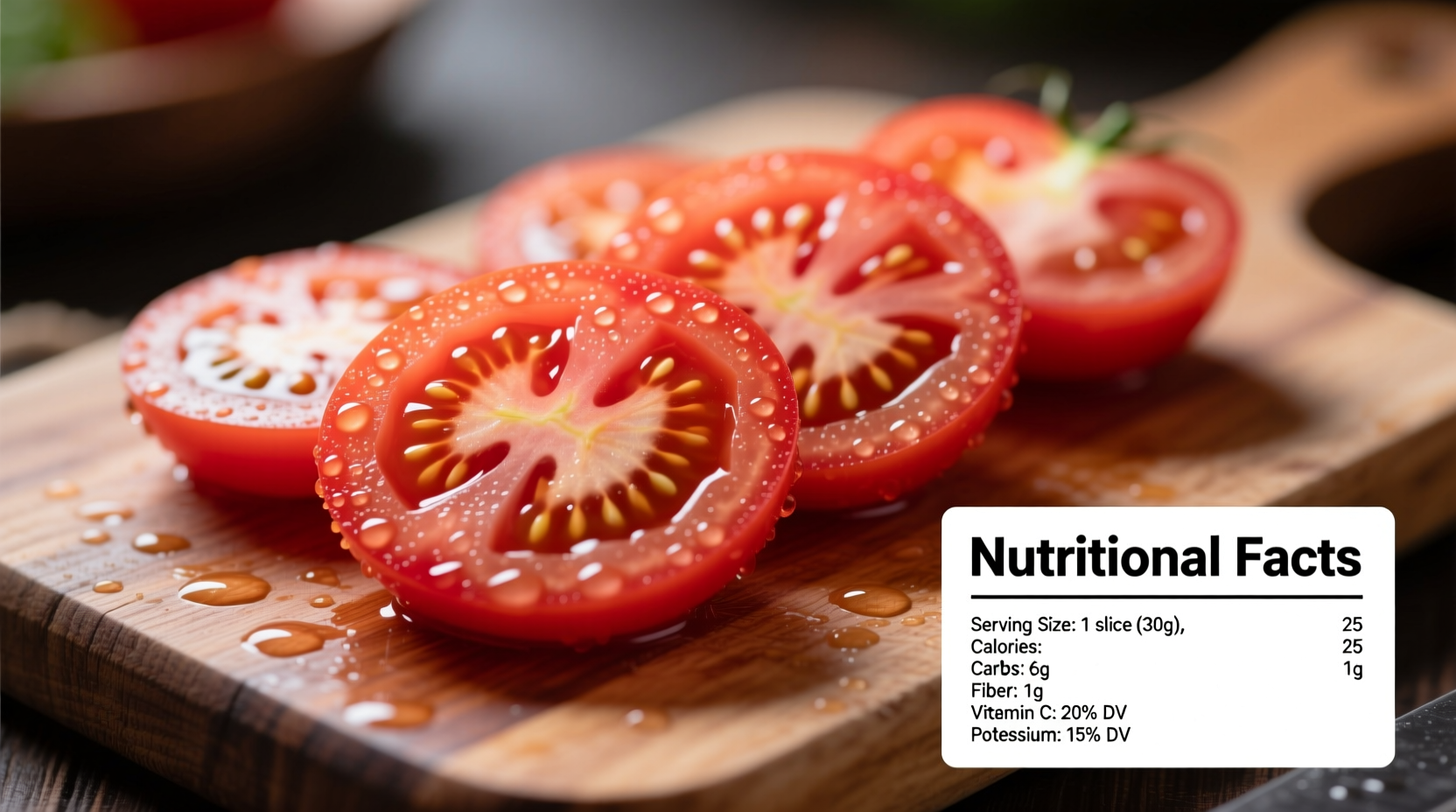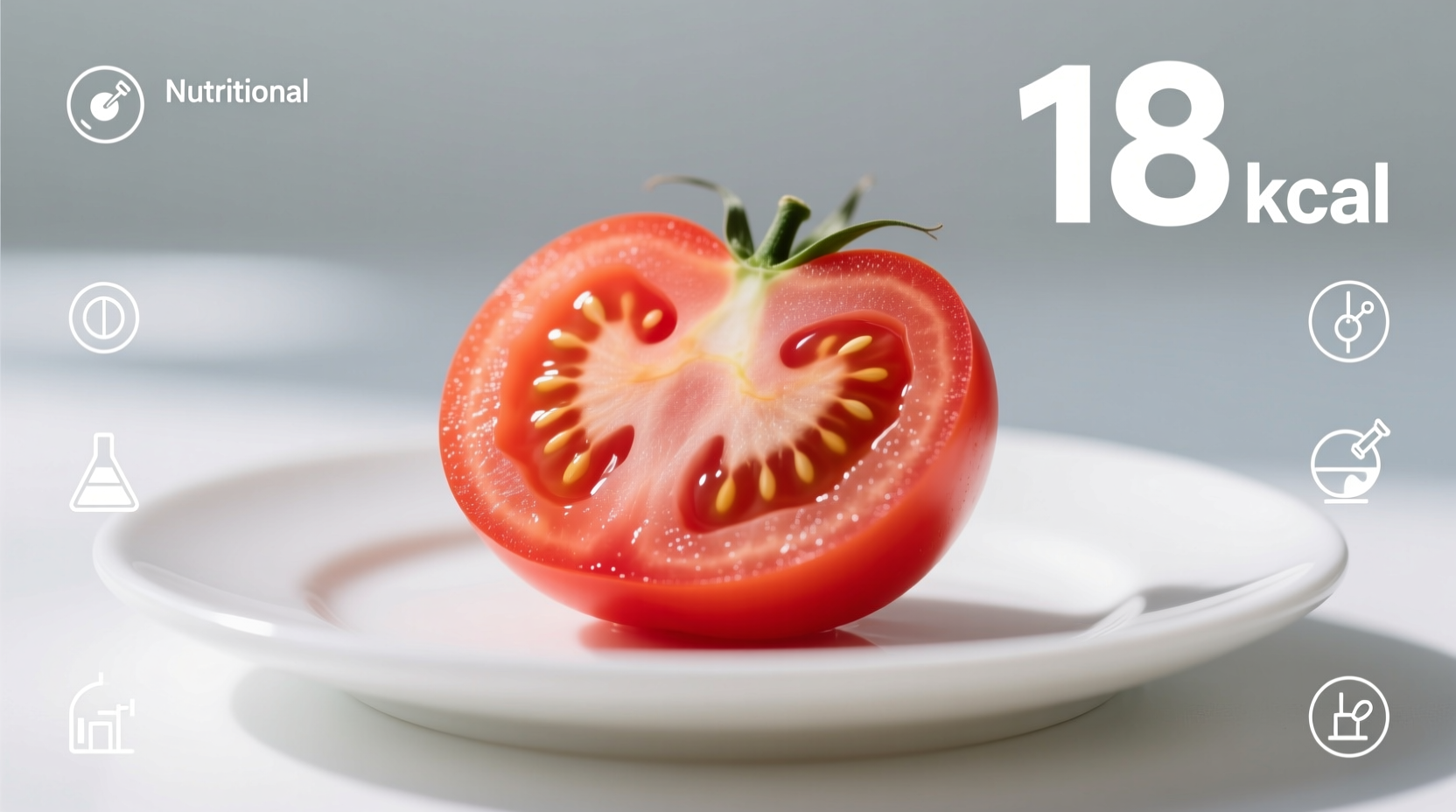Tracking calories doesn't have to mean sacrificing flavor or satisfaction. Understanding the precise nutritional value of everyday ingredients like tomatoes helps you make informed choices without unnecessary guesswork. Whether you're following a specific diet plan, managing portion sizes, or simply curious about what you're eating, knowing the exact calorie content of common foods puts you in control of your nutritional journey.
What Determines Tomato Slice Calorie Count
The exact calorie count in a tomato slice depends on several factors, but the variation remains minimal due to tomatoes' naturally low-calorie composition. Unlike higher-calorie foods where preparation methods dramatically affect nutritional content, tomatoes maintain their status as one of nature's most diet-friendly options regardless of how you serve them.
| Tomato Type | Weight Per Slice (approx.) | Calories Per Slice | Key Nutritional Benefits |
|---|---|---|---|
| Roma | 12g | 2-3 | Higher lycopene concentration |
| Vine-Ripened | 15g | 3-4 | Balanced sweetness and acidity |
| Beefsteak | 20g | 4-5 | Largest size, ideal for sandwiches |
| Cherry | 7g (half) | 1-2 | Concentrated flavor, portable |
This nutritional consistency makes tomatoes exceptionally reliable for calorie counters. According to the USDA FoodData Central, raw tomatoes contain just 18 calories per 100 grams, with the vast majority coming from natural sugars and carbohydrates. The water content (approximately 95%) explains why even substantial portions contribute minimally to daily calorie intake.
Practical Measurement Guide for Daily Tracking
When tracking calories in real-world scenarios, understanding how to estimate portions accurately matters more than laboratory precision. Here's how to apply this knowledge practically:
- Sandwich preparation: Two medium slices (about 25g total) add only 5 calories to your sandwich
- Salad additions: A generous portion of 5-6 slices (75g) contributes approximately 13 calories
- Snacking: Ten cherry tomato halves (70g) provide just 10-14 calories with substantial fiber and nutrients
Unlike processed low-calorie alternatives that often contain artificial ingredients, tomatoes deliver their minimal calorie count alongside valuable nutrients. This natural nutritional package explains why dietitians consistently recommend whole vegetables like tomatoes over artificially created "diet" products.

Nutritional Context Beyond Calories
While the calorie count matters for tracking purposes, tomatoes offer significant nutritional value that extends far beyond their minimal energy contribution. Each slice provides:
- Vitamin C (approximately 3% of daily value per slice)
- Lycopene, a powerful antioxidant with numerous health benefits
- Trace amounts of potassium and vitamin K
- Dietary fiber that supports digestive health
Historically, tomatoes were misunderstood as potentially dangerous (they're part of the nightshade family), but modern nutritional science has revealed their significant health benefits. Research published in the Journal of Nutrition and Metabolism confirms that regular tomato consumption correlates with reduced risk of cardiovascular disease and certain cancers, largely due to their lycopene content.
Smart Incorporation into Calorie-Conscious Eating
Understanding the negligible calorie impact of tomatoes opens strategic possibilities for enhancing meals without compromising dietary goals:
- Volume eating technique: Add multiple tomato slices to sandwiches or burgers to increase portion size without significant calorie addition
- Flavor enhancement: Use tomatoes to add moisture and flavor to dishes instead of higher-calorie sauces or dressings
- Snack satisfaction: Combine tomato slices with a small amount of healthy fat (like avocado) for balanced, satisfying snacks
Professional chefs like Antonio Rodriguez emphasize that "tomatoes provide what we call 'flavor density without calorie density'—they deliver maximum taste impact for minimal energy contribution, making them indispensable in health-conscious cooking." This professional culinary perspective validates what home cooks have discovered through experience: tomatoes enhance meals nutritionally and gastronomically without derailing dietary efforts.
Common Questions About Tomato Nutrition
Many people have specific concerns about incorporating tomatoes into their dietary plans. Here are answers to frequently asked questions based on current nutritional science:
Does the calorie count change if I cook tomatoes?
Cooking tomatoes slightly concentrates their calories by reducing water content, but the difference remains minimal. A cooked tomato slice (15g) contains about 4-6 calories compared to 3-5 for raw. More importantly, cooking increases lycopene bioavailability, enhancing nutritional benefits despite the slight calorie increase.
Are tomato slices suitable for strict calorie-restricted diets?
Absolutely. With only 3-5 calories per slice, tomatoes provide substantial volume and nutrients for minimal caloric cost. They're particularly valuable in diets below 1,200 calories daily, where maximizing nutrient density while minimizing calories is essential for maintaining nutritional adequacy.
How many tomato slices can I eat while staying under 50 calories?
You could consume approximately 10-16 slices of tomato (depending on size) while staying under 50 calories. This represents a substantial volume of food—enough to fill a small bowl—demonstrating why nutritionists recommend volumetric eating (focusing on low-energy-density foods) for weight management.
Do different colored tomatoes have different calorie counts?
The calorie difference between red, yellow, and orange tomatoes is negligible—typically less than 1 calorie per slice. Color variations primarily affect phytonutrient profiles rather than caloric content. All varieties maintain the approximately 18 calories per 100 grams baseline established by the USDA.
Should I be concerned about the sugar content in tomatoes?
A single tomato slice contains only about 0.5-0.7 grams of natural sugar, contributing minimally to daily intake. The fiber content (approximately 0.2g per slice) helps moderate blood sugar impact. For most people, including those managing diabetes, tomatoes represent an excellent low-sugar vegetable option that provides valuable nutrients without significant glycemic impact.











 浙公网安备
33010002000092号
浙公网安备
33010002000092号 浙B2-20120091-4
浙B2-20120091-4